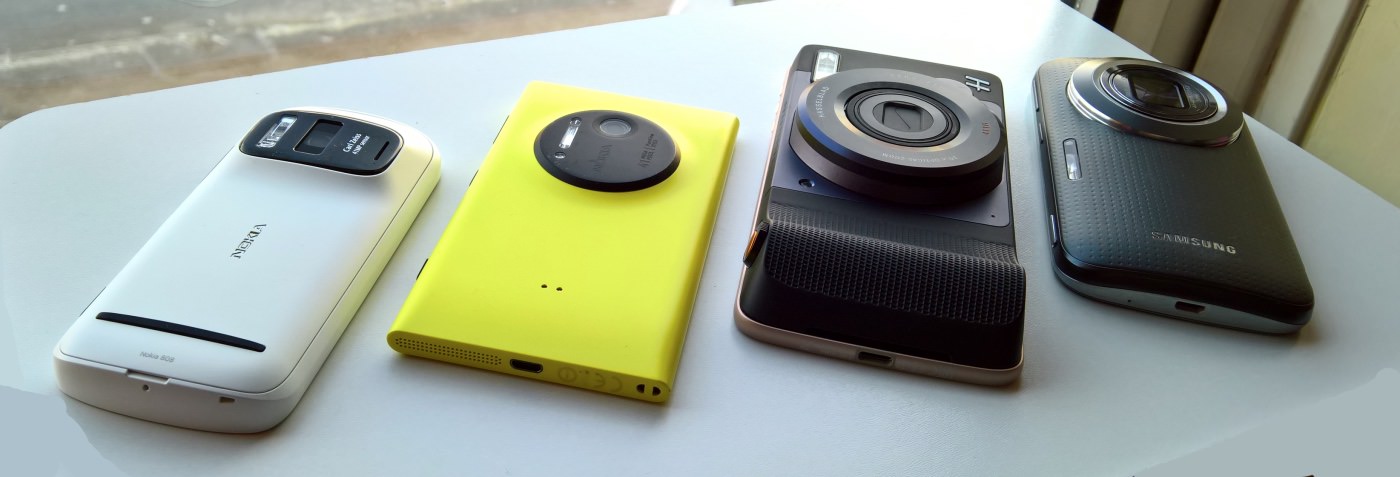
The Lumia 1020 and Hasselblad Moto Mod, flanked by the Nokia 808 and Galaxy K Zoom
So, that caveat - the Hasselblad Moto Mod is almost impossibly huge in day to day life, as we saw in my look at form factors here. The Xenon flash is great, the sensor and general optics pretty good, the zoom mechanism very effective, and so on. But you can't use this all day long as the back half of your main smartphone, which means that you have to detach it and keep it in a pocket. Making finding and re-attaching it something of a 20 second operation (allowing for unclipping and storing whatever other mod you had attached in the meantime (e.g. an extra battery), so it's not exactly perfect for ad-hoc zoomed photos.
Still, there's no denying the effectiveness of optical zoom, where all the magic happens in (physically extending) optics rather than in software tricks cropping into a very high resolution sensor, as on the PureView-equipped 1020.
A few notes before you watch the video:
- As usual, for maximum effect, enlarge your playback window to at least 1080p size and quality. Don't worry about sound, there wasn't much ambient stuff to capture here (other than breeze!), so I've got a music track to add interest - though I did allow the Hasselblad's zoom noise to stay, to give you an idea of how this sounds in real life.
- The Lumia 1020's 'ball bearings' OIS never did work that well in video mode, as I've commented many times. It's better than having no stabilisation at all, but it's not in the same league as more modern OIS mechanisms (even those on the Lumia 930/1520, almost as old now) - I was disappointed by the lack of stability here in my 2016 testing. It's also possible that after three years of use, the bearings here are simply showing their age?
- Because I couldn't physically operate both sets of zoom at the same time, I dispensed with my usual 'jig' system for comparing phone cameras. Here I simply shot the same subjects handheld, i.e. realistically, and haven't worried about synchronising the zoom actions. Don't worry, you'll still get a feel for the relative merits of both systems.
- The 1020 maxes out at about 4x in 1080p capture mode, so I tried to get close to this for the 'first step' when operating the Moto Z with Hasselbad mod. In fact, the physical zoom control is so fiddly on the latter that it proved impossible to stop near this and the video below shows various 'first steps', from 2.5x to 6x - the zooming happens so damned fast that the tiny switch just isn't capable of stopping on a particular zoom factor. But hey, I did my best...
A clear demonstration, of course, that optical zoom trumps PureView zoom, which is utterly as expected. Clever as the latter is - and better than downgrading to lossy digital zoom, as on traditional camera phones - there's no substitute for proper moving optics and the Hasselblad mod on the Moto Z works a treat. Its OIS is impressive, digital noise is kept to a minumum, even in low light (that's the beauty of using a modern 2016 sensor, of course) and being able to see everything crystal clear at a zoom factor of 10x on a 'phone' is astonishing. Just as it was on the Galaxy K Zoom a few years ago. The last Nokia (in fact, the only one?) to feature optical zoom was the N93 in 2006!
I did prefer the richer colours in the 1020 footage on the whole, while the Hasselblad's colours seemed over-muted at times to my eyes. But inconsistently, perhaps confirming that the Hasselblad mod is really in need of a few firmware updates (this is easy via the phone's interface).
Against all this is consideration of form factor though - and you can't help but be impressed by the comparative svelte lines of the Lumia 1020, even today in 2017. That 1020 looks just as sexy today as it did in 2013, even if the OS was left stranded on Windows Phone 8.1 officially.
Your comments welcome. For shooting videos, are the advantages of 10x optical zoom worth carrying around the extra bulk?
PS. Yes, I saw the anouncement of the Zenfone Zoom 3 yesterday, with an iPhone 7 Plus-like 2.3x zoom lens. I'll cover that in due course later in 2017.

